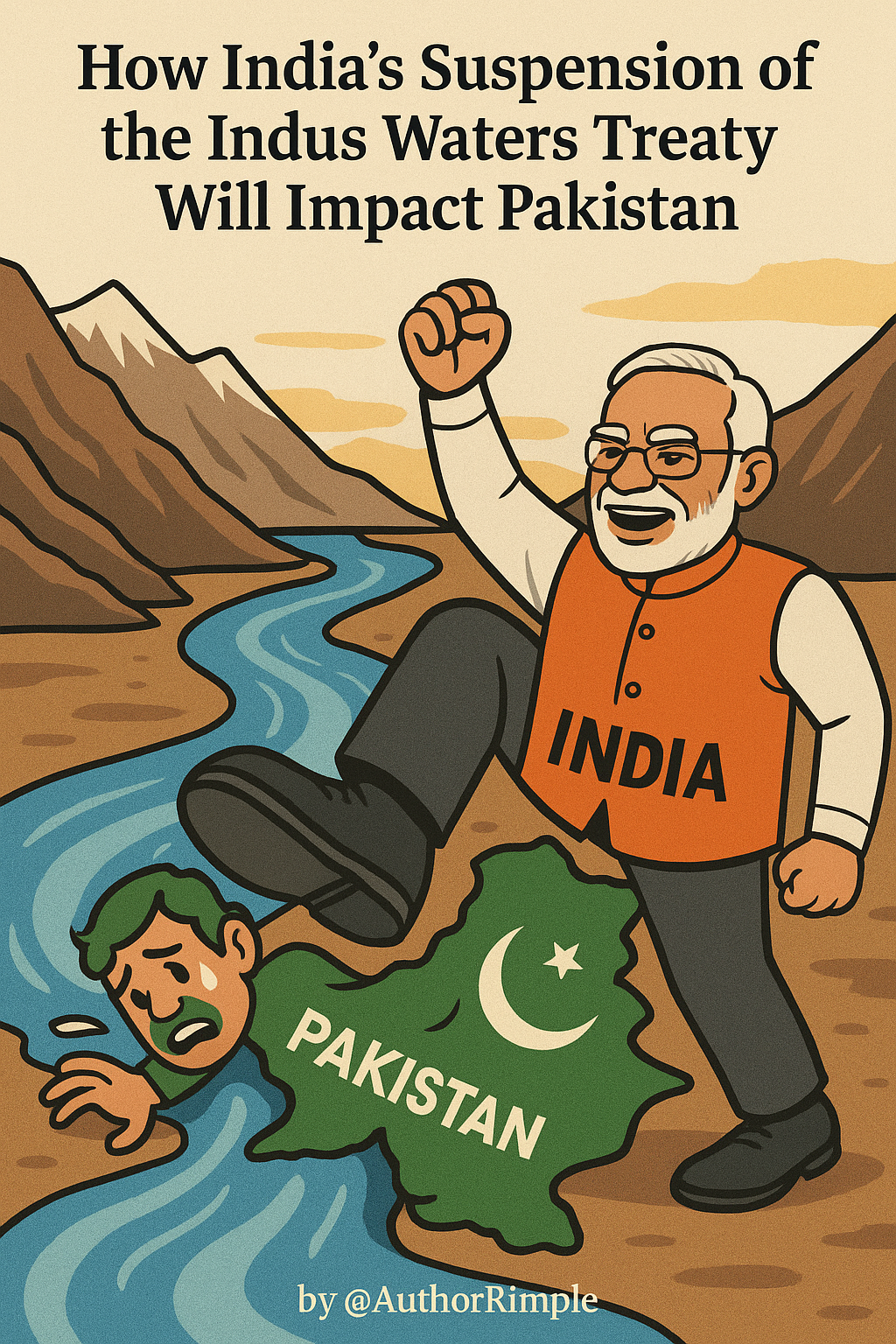The Indian government recently decided to suspend the Indus Waters Treaty, a 1960 agreement that has managed water sharing between India and Pakistan for decades. This decision is a big deal because Pakistan depends heavily on the rivers covered by this treaty for its water needs—about 80% of its water comes from these rivers, especially for farming. Let’s break down how this move will affect Pakistan, from its farms to its drinking water, and explore what India is doing to make things tougher for Pakistan.
What Is the Indus Waters Treaty and Why Does It Matter?
The Indus Waters Treaty was signed in 1960 to share the water of six rivers in the Indus River system between India and Pakistan. India got full control over the eastern rivers—Sutlej, Beas, and Ravi—while Pakistan was given most of the water from the western rivers—Indus, Jhelum, and Chenab. These western rivers are a lifeline for Pakistan because they flow from India into Pakistan, and Pakistan is the “lower riparian” country, meaning it’s downstream and depends on the water coming from India.
For Pakistan, this water is critical:
- Farming: Around 90% of Pakistan’s food production relies on irrigation from these rivers, especially in Punjab and Sindh provinces. Punjab alone produces 85% of the country’s food.
- Economy: Agriculture makes up 20-25% of Pakistan’s economy and employs nearly half of its workforce.
- Daily Life: The rivers also provide water for drinking, household use, and hydropower to generate electricity.
The Indus Basin Irrigation System: Pakistan’s Backbone for Farming
The Indus Basin Irrigation System (IBIS) is one of the largest irrigation networks in the world, covering about 566,000 square kilometers. It’s the heart of Pakistan’s agriculture, supporting millions of farmers and feeding the country. Here’s how it works:
- The system includes the Indus River and its tributaries, along with canals, barrages (like the Sukkur Barrage), and dams.
- It irrigates vast areas of farmland, especially in Punjab and Sindh, where crops like wheat, rice, and sugarcane are grown.
- About 80% of Pakistan’s population lives in the Indus Basin, and 75% of the people depend on agriculture for their livelihood.
Without enough water in this system, Pakistan’s farming would collapse, leading to food shortages, higher prices, and economic problems.
How Will the Suspension of the Treaty Affect Pakistan?
India’s decision to suspend the treaty doesn’t mean the water will stop flowing immediately, but it sets the stage for big challenges for Pakistan. Here’s how it will impact the country:
1. Threat to Farming and Food Security
- Less Water for Irrigation: If India starts blocking or diverting water from the western rivers (Indus, Jhelum, Chenab), Pakistan’s irrigation system will suffer. This could lead to a 32% water shortage by 2025, causing a food shortage of 70 million tons.
- Crop Failures: Crops like wheat, rice, and sugarcane, which need a lot of water, will be hit hard. Small farmers, who are already struggling, will be the worst affected.
- Higher Food Prices: With less food being produced, prices will go up, making it harder for people to afford basic meals.
2. Economic Problems
- Loss of Income: Agriculture is a major part of Pakistan’s economy, contributing 20% to its GDP and 60% to its foreign exchange earnings. A drop in farming output will hurt the economy badly.
- Job Losses: Millions of people work in farming. If there’s no water to grow crops, they’ll lose their jobs, leading to more poverty.
- Energy Crisis: The Indus rivers are also used to generate electricity through hydropower. Less water could mean less power, causing blackouts and affecting industries.
3. Drinking Water Shortages
- Limited Access to Clean Water: About 70% of Pakistanis already don’t have access to safe drinking water. If the river water decreases, cities like Karachi, which already rely on private water tankers, will face even bigger problems.
- Health Issues: Less clean water means more diseases like diarrhea, which can lead to malnutrition, especially in children. This could also make diseases like COVID-19 spread faster.
4. Tensions Between Provinces
- Water Disputes: Pakistan’s provinces, like Punjab and Sindh, often argue over water sharing. A water shortage could make these fights worse, leading to political unrest.
- Rural vs. Urban Divide: Cities might get priority for the limited water, leaving rural areas, where most people farm, with even less.
5. Long-Term Environmental Damage
- Groundwater Depletion: With less river water, Pakistan will likely pump more groundwater, which is already running low. This will make the water crisis worse in the future.
- Flood and Drought Risks: India could control the water flow, releasing too much during monsoons to cause floods or too little during summers to cause droughts.
What Is India Doing to Stop Water Flow to Pakistan?
India has been working on projects for years to use more of its share of water and reduce what flows into Pakistan. Here are some steps India is taking:
- Kishanganga Project: India built a tunnel to divert water from the Kishanganga River (a tributary of the Jhelum) for hydropower. This reduces the water flowing into Pakistan.
- Ratle Hydropower Project: On the Chenab River, this project was revived in 2021. It’s another way India can control water flow.
- Tulbul Navigation Project: On the Jhelum River, this project was restarted in 2016. It can regulate the water flow, affecting how much reaches Pakistan.
- Shahpurkandi Dam: On the Ravi River, this dam has been under construction since 2018 to stop extra water from flowing into Pakistan.
- Ujh Multipurpose Project: On a tributary of the Ravi, this project started in 2020 to divert water for India’s use, reducing Pakistan’s share.
India might also build bigger dams in the future to store water from the western rivers, which it wasn’t allowed to do under the treaty. However, building these dams will take years, so the impact won’t be immediate.
How Will Pakistan Deal with the Water Shortage?
Pakistan is already a water-stressed country, with only about 1,090 cubic meters of water per person each year. This shortage will make things worse. Here’s how Pakistan might try to cope:
- Use More Groundwater: Farmers may pump more groundwater, but this isn’t sustainable as groundwater levels are already dropping.
- Ration Water: The government might limit water for farming to save it for drinking, but this will hurt food production.
- International Help: Pakistan could ask for help from global organizations like the World Bank or take the issue to international courts, but this will take time.
- Improve Water Management: Pakistan needs to use water more efficiently, fix leaky canals, and store more water in dams, but these solutions need money and planning, which Pakistan lacks right now.
- Conflict with India: Pakistan has warned that blocking water could be seen as an “act of war,” which might lead to more tension or even military conflict.
Small Ways This Will Affect Everyday Life in Pakistan
The water shortage won’t just cause big problems—it will also change daily life in small but significant ways:
- Longer Lines for Water: In cities, people may have to wait longer to get water from tankers or public taps.
- Higher Costs: Families might have to spend more money on buying water or food, leaving less for other needs like education or healthcare.
- Health Risks: Without enough clean water, people might use dirty water, leading to more stomach illnesses and skin problems.
- Less Electricity: Hydropower shortages could mean more power cuts, making it harder to cook, study, or run small businesses.
Why This Is a Big Deal for Pakistan
The suspension of the Indus Waters Treaty is a huge challenge for Pakistan because water is tied to almost every part of life—food, jobs, health, and even peace between provinces. While the water won’t stop flowing overnight, India’s actions signal a long-term plan to reduce Pakistan’s water supply. This could lead to:
- A food crisis that makes Pakistan depend on imports, raising costs and debt.
- More poverty as farmers lose their livelihoods.
- Health and hygiene problems that hurt children and families.
- Political instability if provinces fight over the little water that’s left.
Pakistan is already struggling with climate change, floods, droughts, and a growing population. This water crisis could push the country into a much deeper struggle, affecting millions of lives in both big and small ways.





